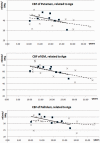Cerebral blood flow in dystonia due to pantothenate kinase-associated neurodegeneration
- PMID: 32851917
- PMCID: PMC7788684
- DOI: 10.1177/1971400920943967
Cerebral blood flow in dystonia due to pantothenate kinase-associated neurodegeneration
Abstract
Background and purpose: The aim of this study was to look for deviations of cerebral perfusion in patients suffering from pantothenate kinase-associated neurodegeneration, where the globus pallidus is affected by severe accumulation of iron.
Material and methods: Under resting conditions, cerebral blood flow was measured by the magnetic resonance imaging technique of arterial spin labelling in cortical areas and basal ganglia in eight pantothenate kinase-associated neurodegeneration patients and 14 healthy age-matched control subjects and correlated to T2* time of these areas and - in patients - to clinical parameters.
Results: Despite highly significant differences of T2* time of the globus pallidus (20 vs 39 ms, p < 0.001), perfusion values of this nucleus were nearly identical in both groups (32 ± 3.3 vs 31 ± 4.0 ml/min/100 g) as well as in total brain gray matter (both 62 ± 6.7 resp. ±10.3 ml/min/100 g), putamen (41 ± 5.4 vs 40 ± 6.1 ml/min/100 g), in selected cortical regions, and the cerebellum. Correlations between perfusion and T2* time to clinical data did not reach significance (p > 0.05).
Conclusion: The absence of any obvious deviations of perfusion in the group of patients during a resting condition does not support the view that (non-functional) vascular pathology is a major pathogenic factor in pantothenate kinase-associated neurodegeneration in the younger age group. The findings underline the value of the arterial spin technique to measure cerebral blood flow in areas of disturbed susceptibility.
Keywords: Pantothenate kinase-associated neurodegeneration; cerebral blood flow; globus pallidus; tiger’s eye.
Figures


Similar articles
-
Looking Deep into the Eye-of-the-Tiger in Pantothenate Kinase-Associated Neurodegeneration.AJNR Am J Neuroradiol. 2018 Mar;39(3):583-588. doi: 10.3174/ajnr.A5514. Epub 2018 Jan 25. AJNR Am J Neuroradiol. 2018. PMID: 29371252 Free PMC article.
-
Cerebral and cerebellar white matter tract alterations in patients with Pantothenate Kinase-Associated Neurodegeneration (PKAN).Parkinsonism Relat Disord. 2022 May;98:1-6. doi: 10.1016/j.parkreldis.2022.03.017. Epub 2022 Apr 4. Parkinsonism Relat Disord. 2022. PMID: 35395584
-
Changes in Cerebral Gray and White Matter in Patients with Pantothenate Kinase-Associated Neurodegeneration: A Long-Term Magnetic Resonance Imaging Follow-Up Study.J Mov Disord. 2021 May;14(2):148-152. doi: 10.14802/jmd.20102. Epub 2021 May 26. J Mov Disord. 2021. PMID: 34062648 Free PMC article.
-
Status dystonicus in pantothenate kinase-associated neurodegeneration due to internal pulse generator depletion: Case study and literature review.J Neurol Sci. 2019 May 15;400:44-46. doi: 10.1016/j.jns.2019.02.038. Epub 2019 Feb 28. J Neurol Sci. 2019. PMID: 30903858 Review. No abstract available.
-
Unraveling the Hallervorden-Spatz syndrome: pantothenate kinase-associated neurodegeneration is the name.Curr Opin Pediatr. 2003 Dec;15(6):572-7. doi: 10.1097/00008480-200312000-00005. Curr Opin Pediatr. 2003. PMID: 14631201 Review.
Cited by
-
Advanced Magnetic Resonance Imaging for Early Diagnosis and Monitoring of Movement Disorders.Brain Sci. 2025 Jan 16;15(1):79. doi: 10.3390/brainsci15010079. Brain Sci. 2025. PMID: 39851446 Free PMC article. Review.
References
-
- Hayflick SJ, Westaway SK, Levinson B, et al. Genetic, clinical, and radiographic delineation of Hallervorden-Spatz syndrome. N Engl J Med 2003; 348: 33–40. - PubMed
-
- Vilchez-Abreu C, Roa-Sanchez P, Fermin-Delgado R, et al. El signo del “Ojo del Tigre” en resonancia magnética: Cambios relacionados con la edad. Anal Radiol Mexico 2013; 3: 189–196.
MeSH terms
LinkOut - more resources
Full Text Sources

